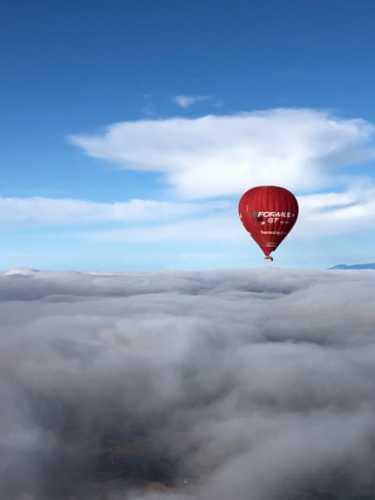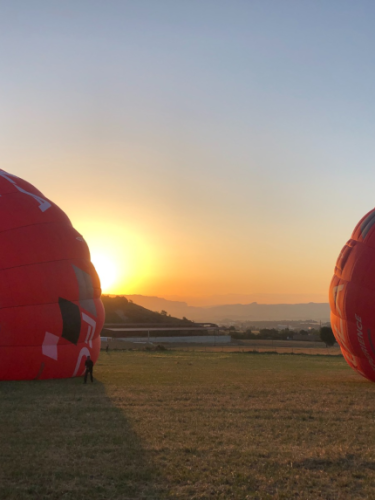Frequently asked questions








Well, ballooning is a weather dependent activity. Our hot-air balloons flies at the speed of the wind and….will land….at the speed of the wind we have close to the ground. The windier it is, the rougher the landing will be. On a normal basis, it is in the morning that we find the weakest wind and the more stable atmosphere to ensure a safe flight. We don’t torture you with the starting time for pleasure!
- CAN WE FLY IN WINTER IN CATALONIA?
-
Yes! The good thing with Catalonia is that we have really good conditions all year long to fly our hot-air balloons. Winter too. Of course, there will be some days that we won’t have the weather conditions to fly but we are really advantaged here.
- WHAT HAPPENS IF WE CAN’T FLY DUE TO POOR WEATHER?
-
In case of unsuitable weather conditions the day of the flight, you will be provided the option to take the balloon tour on an alternative date or be refunded in full (except Gift certificates that are not refundable). No pain in the neck.
Of course, always good to have 2 mornings available just in case. You can inform us at the time of booking.
- WHAT ARE BALLOONS MADE OF?
-
The balloon in itself or “envelope” is made of reinforced nylon fabric. It is very light but very strong at the same time. The envelope is treated with a polyurethane coating to make it more airtight and to help the fabric withstand the ultraviolet rays of the sun which damage the balloon. The pilot and passengers ride in a basket that is made of woven wicker, which is both strong and flexible. it hasn't change a lot in the recent history as we couldn't find a material which would offer the same characteristic (light, resistent to the impacts, strong and durable). The basket is connected to the envelope by stainless steel suspension cables.
- HOW BIG ARE BALLOONS?
-
The most popular sport balloon is approximately 18 meters wide (diameter) and 20 meters high, which is about the same as a 7-story building. It has more than 800 square meters of nylon fabric in its envelope which would be the surface of 2 tennis courts and more than 2,000 cubic meters air capacity which means you could fill it with 2 million liters of water for instance.... And this is a small balloon who can carry 3 to 4 people. Imagine a big one...
- HOW ARE BALLOONS INFLATED?
-
The balloon envelope is spread on the ground and the basket laid on its side and attached to the envelope cables. A portable (gasoline powered) fan pushes cold air into the envelope to give it a balloon shape. When the envelope is about half inflated with outside (ambient) air and gets the shape of a balloon, a propane burner is ignited until the air inside is heated enough for the balloon to rise to an upright position. With a small amount of additional heat, the balloon becomes buoyant. Typically, the inflation takes about 20 minutes. Amazing to see !
- HOW MANY PEOPLE DOES IT TAKE TO FLY A BALLOON?
-
Ballooning in Barcelona's region is a wonderful group or family activity. To safely launch and fly a balloon, it requires a minimum crew of 2 people to prepare the balloon and ensure the flight in itself. A professional pilot up in the air and the chase crew driving the car with the trailer as...we know where we are taking off from but we don't know where we are going to land exactly as...we totally depend on the winds we have on that day. This is the magic of Ballooning. Once the pilot land, the chase crew will help packing back the balloon and drive back to the launch site.
- WHICH GAS DO WE USE FOR FLYING A HOT-AIR BALLOON?
-
Common Liquid propane gas (LPG) is used to heat hot air balloons. Unlike butane, which doesn't actually freeze below 0°C, but can no longer be vaporized, which would make it impossible to obtain that powerful flame in winter to heat the air inside the balloon envelope, propane can withstand temperatures down to - 44°C. Propane is a stable and predictable fuel, but highly volatile (burns easily) which makes it the perfect gas for flying a hot-air balloon. It is carried in liquid form, under pressure in the tanks, and supplied to the burners through flexible hoses. The burner flame may shoot out a flamme of 3-4 meters in the balloon's enveloppe to heat the air inside. During a typical flight lasting around 1 hour with a balloon lifting a 10 passengers' basket, we can consume between 80 and 100kg of propane. Most hot-air balloons have two independent burner and independent fuel systems for added safety.
- WHERE DO BALLOONS LAND ?
-
Since a balloon travels with the wind, it is not possible to determine an exact landing site prior to launch. However, a pilot is able, through the study of wind currents, to determine the general direction of the flight and will decide according to the wind he has and the area where he is flyin what is the best place to land. By law, for safety reason, we have right to land anywhere in case of urgency but we do our best to land on paths, not cultivated fields etc.
- CAN ANYONE PILOT A BALLOON?
-
Balloon pilots must have an official pilot’s licence especially for balloons. This licence is issued by the Spanish local Federal Aviation Administration (AESA) and is earned after taking hours of instruction with a balloon pilot instructor, passing a specified theory written exam, making a solo flight, and passing a flight test with a Civil Aviation examiner. And after that, the pilot has to make, as for piloting a plane, a certain number of flights (more than fifty hours) to be enable to fly with passengers in a balloon company. Our pilots have hundreds of flight hours...
- HOW DO PILOTS STEER THEM?
-
Generally speaking, they don’t. A balloon drifts in the same direction and at the same speed as the wind he has at the altitude where the balloon is. And there is not one direction and speed of wind in the air. According to the flight level he gets, the pilot will find diferent winds with diferent directions. His skills basically is his ability to play with the altitude to use those diferent winds to control the direction of the balloon and land safely at the end of the flight. Altitude control is achieved with the on-board burner. Longer “burns” will achieve lift. Shorter “burns”, or none at all will allow the air to cool, and the balloon to descend. And if the pilot wants to descend faster, he can pull some ropes to open the top part of the balloon to release hot-air and thus cool down the balloon temperature which provokes the descent.
- HOW FAST DO BALLOONS GO?
-
As fast as the wind blows. But if the wind is over 10 km per hour at ground level, balloons are not normally going to be inflated because of the increased possibility of burning the fabric and because landing would likely be rough for passengers and require a large field.
- HOW HIGH DO BALLOONS GO?
-
Flights in hot air balloons have been recorded at over 15,000 meters. However, ballooning is most enjoyable when flying 400 to 1,200 meters. Or just above the treetops. The beauty of ballooning is that by changing of altitude you will constantly change the views. For us (of course!), the best way to discover a region !
- HOW LONG CAN BALLOONS STAY UP?
-
Most balloons can fly for about 1 hour depending on the outside temperature and the weight carried. On a cold day with only the pilot flying, a 2-3 hour flight would be possible. Hot air Balloons can fly all year round with calm winds. For a flight, the pilot always has more gas than necessary for the planned flight time to have margin for landing.
- HOW DO BALLOONS WORK?
-
Hot air is lighter than the air : it rises. The envelope traps a large bubble of hot air. When the air in the envelope is heated by the burner, the balloon will rise. When the air in the envelope is allowed to cool or if the hot air is “vented” (allowed to escape) from the top of the envelope, the balloon will descend. An altimeter (to measure altitude), a rate-of-climb meter, and an envelope temperature gauge are the only instruments used in the balloon. Amazingly, the pilot can control the altitude of the balloon within a matter of a few meters!

